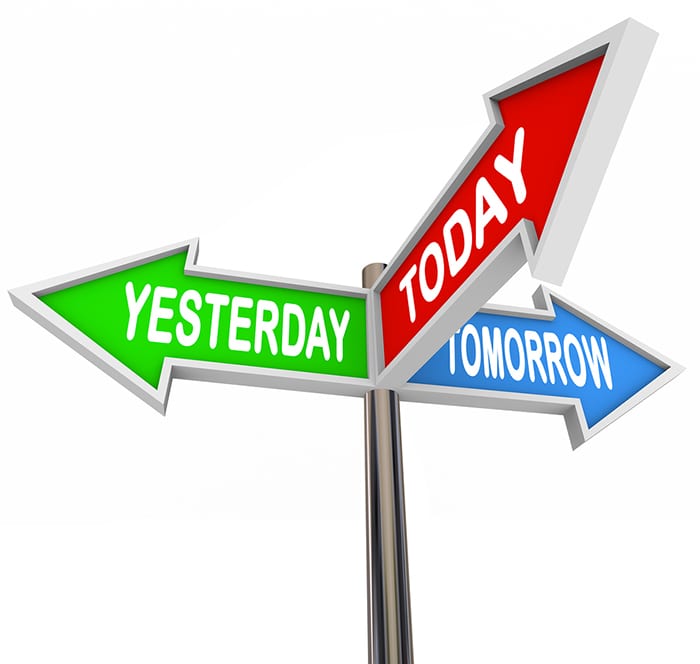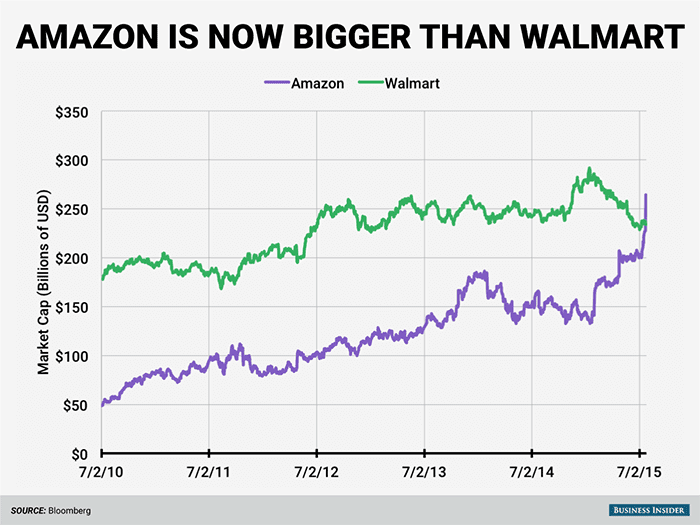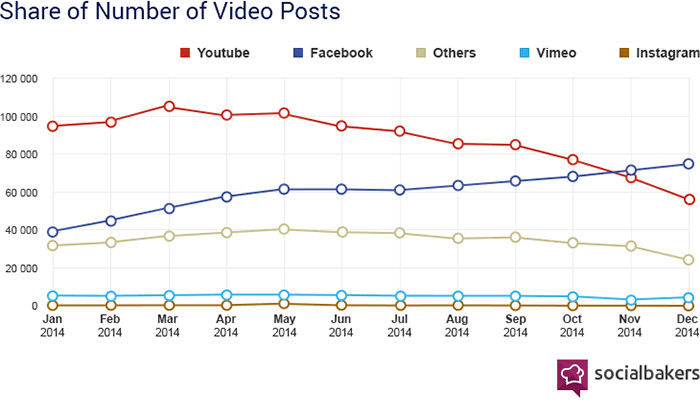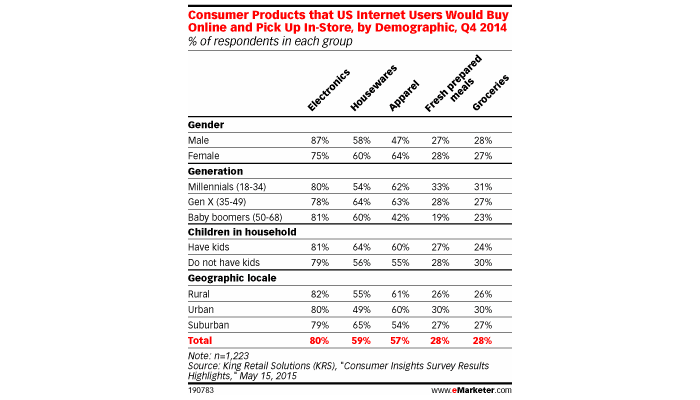Future Of Ecommerce: 10 Predictions For 2016

It’s a brand new year. 2016 is underway and that means it’s time for us to kick off the year with our predictions on the future of ecommerce. We wrapped up last year with our post 16 Unbelievable Online Shopping Facts From 2015. Now it’s time to look ahead and make our predictions.
Amazon Will Become The New Wal-Mart
The collective commerce community has wondered whether and if ever an entity would be able to top the juggernaut status that is retained by Walmart. But, ironically, it has been done by an ecommerce marketplace: Amazon. According to Business Insider, Amazon is now larger than Walmart.
While Walmart is worth an estimated $2.33.5 billion, Amazon is now worth an estimated $264 billion. What’s brilliant here is that Amazon is a marketplace, not just a wholly owned subsidy. It’s ironically a conglomeration of smaller online businesses all competing for marketplace relevance and using Amazon as their primary hub. In the end, even though Amazon is the big guy at the top, the small business ultimately defeated Walmart in the future of ecommerce.

Ecommerce Will Represent 10% Of All Retail
Ecommerce is on the fast track for growth. Telling of this was the 17% year over year growth that was experience from 2014 to 2015. Internet Retailer said that in the U.S., ecommerce would do over $300 billion this past year, and they were correct. As of last year, the numbers showed that worldwide this industry represented over 6% of retail.
But newer predictions are emerging, such as the YCHART you see below that shows that between the start of last year and the beginning of this year, ecommerce grew to represent 7.40% of all retail in the U.S. So it’s not that farfetched to predict that in the next year it could creep into the 10% marker, with some experts saying that it will be at 18% by the year 2018.

Facebook Will Overtake YouTube For Branding
A lot of brands seek to establish themselves by using YouTube, the most popular video file sharing site in the world, to represent themselves. Up until recently, it was the go-to place for brands that wanted to advertise via digital video medium. But in recent months, Facebook has crept from being underdog to the top dog.
According to a Social Baker report that analyzed more than 180,000 Facebook video posts that were spread across over 20,000 Facebook pages for brands, it was found that Facebook gets brands more video views than YouTube does. Expect this trend to continue well into this year and beyond as the two social giants do battle to see who can win the digital marketing dollar. Check out the chart below for even more clarity.

Emotionally Driven Shopping Will Become New Standard
Consumers are emotional when they shop already, explains Entrepreneur Magazine, and this element is being studied by marketers. For the branders that “establish a brand identity,” they are working to build a more viable and veritable relationship with their customers. Of course, this process has been and is piggybacked by social media. But the point remains steadfast: emotional based marketing works.
For example, the ability to share shopping lists will become trendier. And newer shopping apps/services like Wanelo will take center stage as top referring engines, as online social shopping communities emerge that put the shopper’s emotions at the center of the branding strategy.
In-Store Pickup Will Save Big Box Chains
Have you ever bought something from a big box store like Best Buy, Target or Walmart and requested the convenient in-store pickup method? It’s a lot faster than waiting for the product to ship to your home, and you don’t have to pay a shipping fee. Sometimes, the business will even offer to ship a product that’s not available in their stores to the store for free (as opposed to charging you), and then will notify you when it’s ready to get picked up.
This innate perk appeals to the majority of consumers. In fact, according to a King Retail Solutions survey, 78% of shoppers want to be offered this convenience. Even the millennial generation, which was the least fond of the prospect, weighed in at a majority of 74% in favor of buying online with in-store pickup. But just 21% of executives at these major stores say that they’re equipped to offer this amenity to shoppers. And according to Boston Retail Partners, only 24% of retailers in the U.S. are even offering this option at the present. Expect this number to expand rapidly in the year to come as retailers realize that they are losing out on revenue by refusing to offer this service. It’s part of the future of ecommerce.

Competitors Will Copy Amazon Prime
It’s hard to top the offerings of Amazon Prime. The conglomerate has really made its service standout with a myriad of offerings that few other retailers can ever hope to offer. And so it stands alone at the top of the list, according to Tech Crunch. But, as other retailers catch up to the convenience of this marketplace, it’s no longer alone in its offerings to consumers.
A few competitors have entered the fore, with less of an offering but an alternative nonetheless. Take for example Premier (offered by Newegg). For $50 per year, subscribers can get free three-day shipping and free returns, a similar contrast to Prime. Then there’s another service called ShopRunner, which offers free two-day shipping and free returns, available for use on a select group of retailers that includes the likes of retailers like Neiman Marcus, GNC, The Limited and dozens of others.
While it will be virtually impossible to ever clone Amazon Prime, the demand is apparent for similar services. In 2016, don’t be surprised when more of these subscription based shopping services pop up. In the end, however, none will be able to offer streaming video, digital libraries, streaming music or drone deliver systems, so Prime will still remain at the head of the pack for quite some time to come, as it’s been the catalyst for the future of ecommerce.
Drones Will Begin Delivering Packages
Speaking of Amazon Prime, soon competing retailers will have to deal the reality of the future of ecommerce: Amazon Prime Air. This involves using accordable flying drones to deliver packages to customers in just a few hours in the same city. One has a mind to think that carrier services including the USPS, UPS and FedEx are far from thrilled at the prospect of losing more business to drone delivery craft (or are skillfully creating their own fleets to compete).
According to 60 Minutes, Amazon is amassing an impressive fleet of these small gyrocopter drones that cost just a few thousand apiece, require minimal maintenance and are run on electricity. They will be capable of delivering packages up to 80 pounds to most major metropolitan residences within hours of the order having been placed. If the 1950s could see us now, the first thing they’d ask is: “What the heck is ecommerce?” But if 1998 could see us now, it’d be all drop-jawed.
Marketplace Selling Will Shift The Industry
Marketplaces are quickly becoming the new norm. For instance, artisan marketplace Etsy had its initial public offering last year and now leads the pack as the premier artisan marketplace (there really wasn’t such a thing that existed before Etsy, but the same was true for Amazon, too). As the industry develops, the future of ecommerce wil reveal that marketplaces are the new hub.
Consumers are fond of marketplaces because they connect them to thousands of stores and millions of products at one website. Most marketplaces have a set of strict standards that stores must adhere to, or they will be delisted. As a result, consumers can know that they are buying from reputable stores using secure encryption with a proven standard of service.
In addition, marketplaces give smaller businesses a place to showcase their goods and attract more business than they would just by hosting their own website. They are so popular, in fact, the Intuit provides a list of 20 where anyone can list their product for sale.
Mobile Shopping Will Overtake Desktop
All online retailers are aware that the holiday shopping rush is where the big bucks are earned. With newer and more capable smartphones and tablets available, more consumers are choosing to shop online from a mobile device than from a laptop or a desktop. And retailers have adapted as rapidly as possible, assuring a relatively seamless shopping experience between devices.
Over the past holiday shopping season, the Associated Press reported that smartphone shopping overtook desktop shopping during the holiday season. By the end of 2015, mobile web usage already was outdoing desktop web usage by a small margin (see the chart below). An estimated 56% of holiday shoppers actually used a mobile device, too. And this year, we’ll see an even sharper increase. Our prediction: 60% of holiday shopping will come from smartphones and tablets in 2016.

Easy Returns Will Be Expected By Consumers
Returns have long been considered a pain point by retailers, but consumers see hassle-free returns as the future of ecommerce. One reason is because 23% of returns are due to the wrong item being shipping. Another reason is because 22% of the time products look drastically different in person than they do online. And yet another includes that 20% of the time a damaged product is received.
As retailers begin to realizes that offering easy product returns actually improves their profit margins (as demonstrated by Amazon, Zappos and a long list of other retailers), expect more to get on board with this mantra in 2016.
Here are the hard facts on returns as part of the future of ecommerce. If you are retailer, make sure you are paying close attention.
- 88% of shoppers will take the time to read a retailer’s return policy.
- 77% of retailers provide a specified return period.
- 66% of shoppers will actually read the policy before they make a purchase.
- 40% struggle to find the return policy, which can lead to abandonment.
- 38% are dissatisfied with the clarity of the returns policy.
- 15% of consumers abandon the shopping cart if the returns policy is unclear.
What Shoppers Will Want In 2016
The most recent statistics shed some light on what consumers want from an online product return policy in the future of ecommerce.
- 50% of shoppers think that returns can be easier to make online.
- Just 42% are satisfied with the process of making returns or exchanges.
- 86% want a return shipping label provided by the retailer.
- 68% think free return shipping equates to a positive shopping experience.
- 63% of consumers are dissatisfied with paying for return shipping costs.
- 52% want the return shipping label included in the box.
- 51% will not make a purchase if a return label is not included in the box.
Offering hassle-free returns is naturally the most ideal solution for appeasing your growing customer base. However, a few other related and important factors also shouldn’t be overlooked along the way, either, and are culled from our most recent white paper about online product returns.
- Over 63% of consumers read the online product returns policy before making a purchase (comScore).
- 81% of consumers want a convenient returns policy that is hassle-free with no return shipping cost (UPS).
- About one-third of all products ordered online are returned by consumers (WSJ), so understanding that returns are part of the buying process is important.
- When free returns are offered, purchases can be increased by up to 357% (CNBC).
- When return shipping fees are charged, 81% of consumers are less likely to make a future purchase (Upstream Commerce).
- Zappos gets 75% improved customer loyalty, repeat buyers from free returns, even though they charge more for their products (eCommerce Digest).
Share On:









